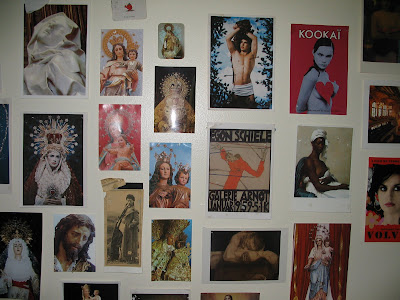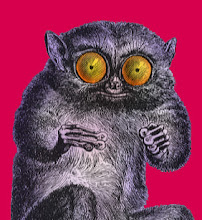For the last four years, I've made a list in the front of my diary of all the books that I read during that year. Looking back on these lists is a real pleasure - it brings back a particular kind of memory of the "texture" of the year. It reminds me of the reading experiences that tickled my brain, sparked ideas and furthered interests, but also of what I was doing and how I was feeling at the time.
So although the year is not yet ended, and I may squeeze in another book yet, here's my 2007 reading roundup - in the order in which I read them. Don't worry - there are no spoilers.
Tourist Season (Carl Hiaasen) - Holiday fluff picked up in Apollo Bay. Ok, fluff with shards of glass in it, but fluff nonetheless.
Take a Girl Like You (Kingsley Amis) - Teeth-grindingly dull, irritating and horribly dated. I kept on hoping it might get better, because I loved Amis's
Lucky Jim so much. It made me laugh uncontrollably. No such luck with this one though.
The Ancestor's Tale (Richard Dawkins) - Love love love. Rave rave rave. This book is a "backwards journey" through evolution, showing how and when we humans link up with every other living thing on earth. Last year I read
The God Delusion which was a life-changing book: I was already an atheist, but
The God Delusion made me want to stand up and be counted. The Ancestor's Tale is all science but is no less engrossing.
Hamlet (William Shakespeare) - I've been reading this repeatedly throughout the year - of course!
Will in the World (Stephen Greenblatt) - excellent book about Mr Shakespeare. Very little is known about the life of the Bard, and much has been written about the little that is known. This book is fascinating because it builds up a picture of what English life and society was like in Shakespeare's time, and then muses on how Shakespeare himself may have experienced it, and how this experience may have shaped his work. Imaginative history, and extremely engaging.
The Secret River (Kate Grenville) - gripping, revealing, evocative and pretty damn horrific.
Rumpole Rests His Case (John Mortimer) - the Big Squid is a huge Rumpole devotee, and swears by a dose of him for relaxing the frazzled brain. Especially timely after reading
The Secret River.The Arrival (Shaun Tan) - Love love love love. Rave rave... Genius.
The Patron Saint of Eels (Gregory Day) - this book made me groan - and not in a good way. I thought it was sentimental, heavy-handed, tedious and obvious. Nice cover (I am very partial to eels), but what a spectacularly annoying book.
Men and Cartoons (Jonathan Lethem) - Have to admit I can't remember a whole lot of this collection of short stories. I am a fan of Lethem's novels though - especially
The Fortress of Solitude.
Black Swan Green (David Mitchell) - Mitchell's
Cloud Atlas blew me away when I read it last year, so I had to turn up the receptors a bit for this more low-key, straightforward story. It was very good though, and the adolescent narrator's voice was extremely authentic - as was the meticulously remembered early 80s setting. The recent film
This is England reminded me of Black Swan Green quite a bit. A terrific, wrenching film, incidentally.
Old Filth (Jane Gardam) - wonderful writing, some unexpected twists, and a fascinating glimpse into the lives of "Raj Orphans", the children of well-to-do expats sent "home" to England during the war - a place that was not home to them at all.
We need to talk about Kevin (Lionel Shriver) - a huge book, which has come back to my mind many times. It is highly contentious, and forces the reader to take sides, whether they want to or not. Brings out our judgemental side, and then (hopefully) makes us question it. Very powerful. There was an aspect (which I won't go into because it would spoil it) that made me feel that as a reader I was being seriously manipulated - an experience I don't like - but I'd still definitely recommend this one.
Notes from the Teenage Underground (Simmone Howell) - this is a "young adult" book sent to me by my editor at Pan Macmillan. I haven't read YA fiction since I was in my early teens, and find it hard to comment on it. This one seemed pretty good - aimed squarely at teen girls with arty/rebellious leanings. Wonder what I would have made of it as a teen?
Gravity (Scott Gardner) - YA fiction aimed at boys: drinking, responsibility, what to do with your life etc. Not my style of book - I was more a Catcher In the Rye-reading kind of teen. (Ok, that's the last of the YA stuff for the year).
Let the Right One In (John Ajvide Lindqvist) - Ohhhhhhhhh I ADORED this book! It's a horror story with vampires, but emphatically NOT of the world of cloaks, chalices, castles and all the other cliched accoutrements of fantasy. I will declare my bias right away - I hate fantasy novels. Anything with a wizard, a dragon, an ancient curse, a magical book, or a goddamn ring in it in it makes me want to go on an elf-stomping rampage. But this book is set in the grimy, super-realistic setting of a dormitory suburb in Stockholm, and the vampire is a dirty-looking little girl, the object of desire of a paedophile... Oh, and it's a love story too. A brilliant book - funny, hideous and so close to the edge you wonder how the hell Lindqvist did it. I can't wait for the movie - it'll be a scream.
Hotel Babylon (Imogen Edwards-Jones) - Total waste of time. Not even worth criticising.
The Brooklyn Follies (Paul Auster) - Big thumbs up - really enjoyed it.
The Bay of Noon (Shirley Hazzard) – I think Shirley Hazzard is great. Her writing reminds me of a wonderful watercolour painting where the artist makes it all look free and spontaneous – lots of luminous washes and subtle hues.
Happiness (Matthieu Ricard) - Life changing! I read it twice, making lots of notes. Ricard is a French super-scientist turned Buddhist monk. He explores scientific and Buddhist philosophical analyses of happiness and sets out some very useful meditation exercises for training your brain to promote wellbeing. I find the techniques extremely useful. My mate Andrew once told me that Buddhism was almost exactly the same as Cognitive Behavioual Therapy - and this book does draw many parallels. Highly recommended. Good for the life of the mind, and not faith-based at all.
Dead Europe (Christos Tsiolkas) - very disturbing and confronting. This book made me want to meet the author and ask him a lot of questions. I needed another dose of Rumpole after this one. But instead I read...
The Time Traveler's Wife (Audrey Niffenegger) - Wonderful! Amazing! Where did I put that box of extra-special superlatives? An instant favourite book, which is a big call.
The Fate of the Artist (Eddie Campbell) - I read this in a rush, as I was due to meet Eddie for the first time that week, and didn't want to arrive in complete ignorance. It was a bit unnerving to meet a person after just having read about various intimate details of his life! Bittersweet-funny. I especially liked the adaptation of the O Henry story at the end.
From Hell (Alan Moore and Eddie Campbell) - Part 2 of my preparatory reading. Took me a good while to get into this - I initially found it very hard to read. An amazingly detailed, meticulously researched and creepy book.
The Black Diamond Detective Agency (Eddie Campbell) - I really enjoyed this. Gorgeous painting in gouache, and a rip-roaring story.
Pyongyang (Guy Delisle) - Fabulous fabulous fabulous. I loved every frame. This is Guy Delisle’s cartoon diary of a few months spent in the ultra-weird world of the North Korean capital city. A revelation. Funny and shocking and very sharp and true.
Unpolished Gem (Alice Pung) – memoir by Melbourne lawyer and writer, about growing up between two cultures and experiencing the pressures of both, set in the Western suburbs of Melbourne. Alice Pung was in hear early 20s when she wrote this – impressive.
The Yiddish Policemen’s Union (Michael Chabon) – another instant favourite. You’ll think I’m just a big tart when it comes to favourite books, but seriously – it’s been a good year. Chabon is absolutely brilliant. Love love love… more love…
Shenzhen (Guy Delisle) – great stuff – though Pyongyang was even better.
After the Snooter (Eddie Campbell) – a little insect tells me this isn’t the last we’ll hear of this creature.
The Question of Hamlet (Harry Levin) – a slim volume packing huge insights. Excellent commentary, and invaluably helpful for my Hamlet adaptation. Yay for eBay, where I bought it.
Othello (William Shakespeare, adapted by Oscar Zarate) – an excellent cartoon adaptation. The faces reminded me a bit of Japanese masks – especially Iago. Rises wonderfully well to the drama and passion of the play. Some really nice layouts, and no annoying flashiness.
American Born Chinese (Gene Luen Yang) – I quite enjoyed this, though the interweaving of the “spiritual” monkey tales with a Christian bent didn’t do it for me. The slice of life parts were good though.
Understanding Comics (Scott McCloud) – I’d managed to put off reading this for years, and finally got down to it. Good stuff, which wouldn’t have seemed at all contentious to me until I encountered the Force That Is Campbell. It didn’t change my life, but then, I already do comics.
King Lear (William Shakespeare, adapted by Ian Pollock) – I’m still in two minds about this adaptation. The drawing style is wild and very creepy, and I like it a lot. But I think the interaction of the characters, and the “acting and direction” plodded a bit. My friend Greg described it as “claustrophobic”.
Rooftops (Mandy Ord) – see
here for more.
Shakespearean Tragedy [part only] (A. C. Bradley) – apparently this used to be the standard school text for studying the Tragedies. Written in about 1909 (I think), it’s pretty stodgy stuff.
Persepolis I and II (Marjane Satrapi) – Great stuff – ashamed that I hadn’t read it sooner. It left me wanting to know more, more, more about the details and consequences of many of the episodes.
Modern Hamlets and their soliloquies (Mary Z Maher) – Fascinating. Again, an invaluable tool and a great prompt for looking at the character of Hamlet from different perspectives. Glad I read it when I was already well into the roughs though - it might have been overwhelming otherwise!
Now reading…
The Human Mind [and how to make the most of it] (Robert Winston) – fascinating and thought-provoking popular science of the lighter, easier-to-read variety. Enjoying it very much.
So - any recommendations?
 When I tried to scan this, I discovered just how appallingly useless my scanner is - so this is a photo. Come new year, I'm getting a new whiz-bang replacement scanner (rubs hands like a fly).
When I tried to scan this, I discovered just how appallingly useless my scanner is - so this is a photo. Come new year, I'm getting a new whiz-bang replacement scanner (rubs hands like a fly). The paler pink consists of hundreds (maybe thousands?) of tiny little concentric circles painted with a 0-size brush. Took me hours, and of course it is nowhere near finished yet. Ah, joy! Is it any wonder I have eyes like a tarsier?
The paler pink consists of hundreds (maybe thousands?) of tiny little concentric circles painted with a 0-size brush. Took me hours, and of course it is nowhere near finished yet. Ah, joy! Is it any wonder I have eyes like a tarsier?















